| Article ID | Journal | Published Year | Pages | File Type |
|---|---|---|---|---|
| 8071506 | Energy | 2018 | 35 Pages |
Abstract
The potential use of mineralogical carbonation is greatly acknowledged not only in reducing CO2 emissions through carbon capture and storage (CCS) but also in producing industrially viable products. The direct carbonation of stable silicate minerals by supercritical CO2 is unrealistic due to the low conversion efficiencies. The natural abundance of silicate minerals (e.g., olivine) is theoretically sufficient to fix the entire quantity of man-made CO2 emissions, while carbonation of sorbents obtained from the dissolution of silicate rocks could proceed in a multistep (or continuous) process. In this work, the optimum experimental conditions for a multistep procedure of sequestration of minerals and conversion of CO2 into valuable products were investigated using synthetic forsterite. In this research, magnesium sulfate obtained from the dissolution of forsterite in aqueous H2SO4 was successfully carbonated to produce valuable byproducts (e.g., silica and hydrates of magnesite) with an economical carbonation as a means of CO2 mitigation. Hydromagnesite, while being commercially applied in various fields (e.g., fire retardation and catalysis), can be transformed to magnesite which is stable for millions of years.
Related Topics
Physical Sciences and Engineering
Energy
Energy (General)
Authors
Waseem Raza, Nadeem Raza, Henry Agbe, R.V. Kumar, Ki-Hyun Kim, Jianhua Yang,
